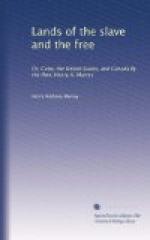[Illustration: HUDSON RIVER STEAMER.]
Let us now look at Mr. Fulton’s part in the transaction. In 1801 he visited Scotland, and was present at one of the experiments making by Symington on the canal, and from him he obtained permission to make full sketches and notes of both boat and apparatus. The fact is sworn to on oath of the presence of an American gentleman, who called himself Mr. Fulton, during the experiments; and further evidence is found in the fact that the engines he ordered of Messrs. Boulton and Watt for the “Clermont” were precisely of the same dimensions as those in the “Charlotte Dundas,” with the exception of two inches more diameter in the piston; and the patent of Fulton dates from 1809—twenty years after Symington had propelled a boat by steam on Lake Dalswinton, and eight years after he had himself taken sketches of Symington’s engines in the Forth and Clyde canal-boat.
Beyond the foregoing evidence, there is the testimony of Mr. Bell that, at Fulton’s request, he sent him information, plans, &c., of Mr. Miller’s first experiments. The long and the short of the story is clearly this:—Mr. Fulton was a shrewd and clever engineer. He came to England, copied the steam-engine which Symington had combined—one can hardly say invented—and then returned to his own country, and applied it successfully, for which the Republic ought to be thankful to him, and to honour his name; but, for a president of a college lecturing before a mechanics’ society, to call Fulton the inventor “of applying a known force in a new manner and to new and before unthought-of purposes," exhibits an ignorance or an assurance, for neither of which the slightest excuse can be made.[CJ]
With equal accuracy Mr. King informs the mechanics that “Colonel John Stevens had clearly worked out in his own mind, long before any locomotive was constructed in Europe, the theory of such an application of steam, and the actual form in which it could be advantageously made, as well as the cost of constructing and working a railway for the use of locomotives.” If this were true, how does it happen that the son of the Colonel, an able and ingenious mechanician, came over to George Stephenson, at Liverpool, to learn what he was doing, and to order engines from him; but Mr. King out-herods Herod, for he claims on behalf of the Colonel, the working of Steam expansively in 1815, for which Watt had taken out a patent thirty-five years before. If presidents of colleges in America cannot in their lectures deal more closely with facts, the instruction given within the walls of the college will come under very unfavourable suspicions.




